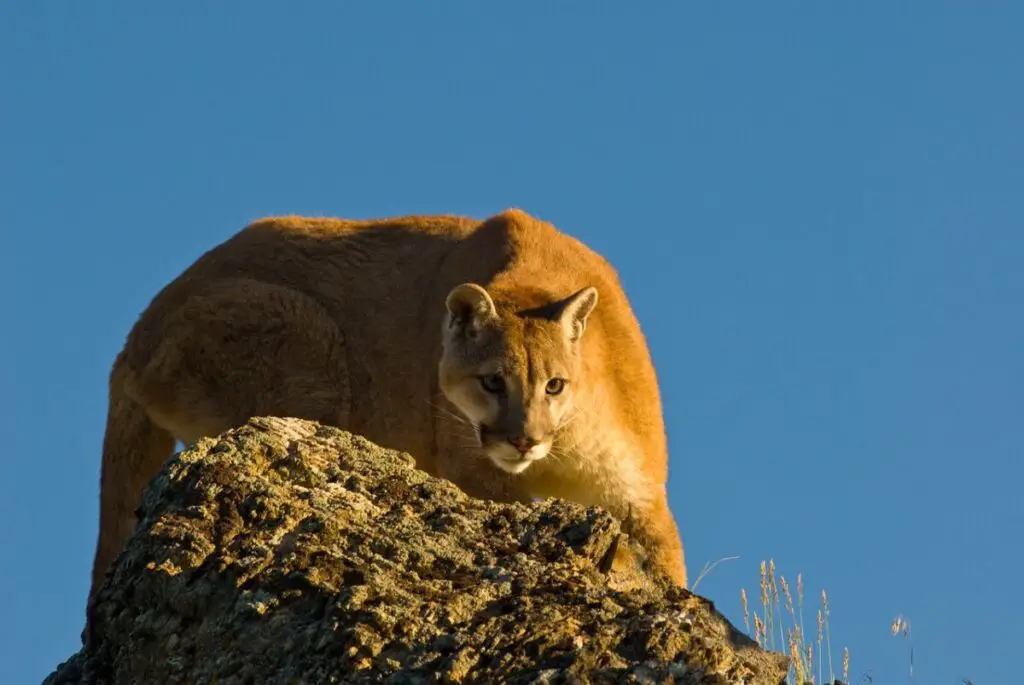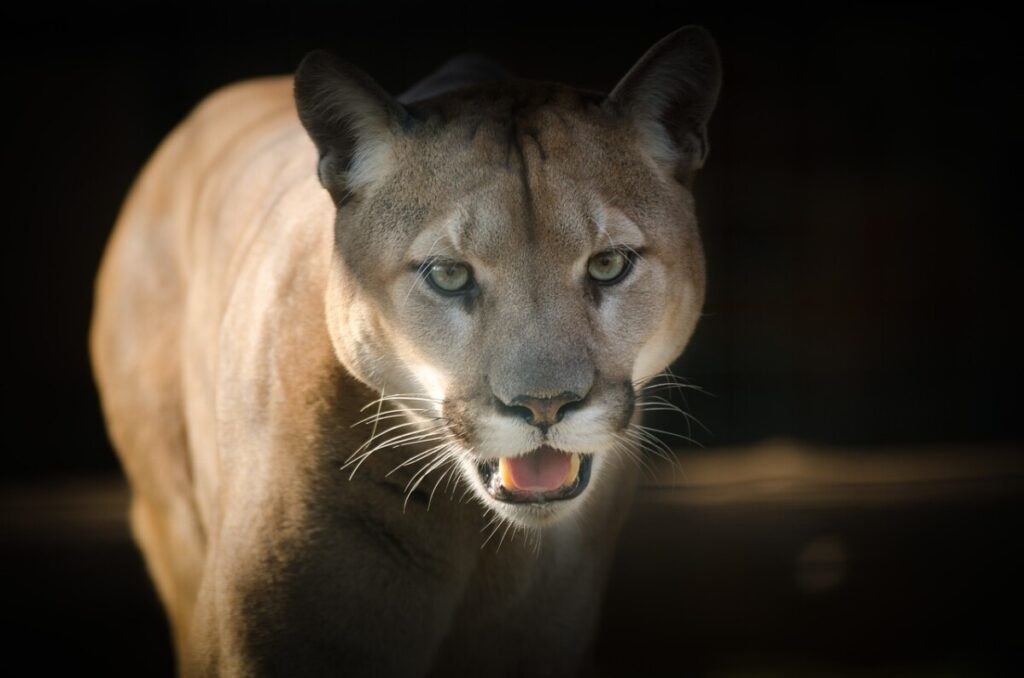Cougar (Puma concolor) or mountain lion, is a large cat species native to the Americas. It is one of the most widely distributed land mammals in the world and an apex predator in various ecosystems. The cougar has been subject to extensive study by biologists and ecologists due to its wide range and unique predatory behavior.
The cougar is known for its quick adaptability and ability to thrive across diverse environments including deserts, forests, mountains and even urban areas where they often come into conflict with humans. They are typically solitary animals that hunt small game such as deer, rodents and rabbits but can take down larger prey if necessary. Cougars have recently become more visible due to increased human activity leading to greater sightings both within their natural habitat and outside it.
Despite being one of the largest cats in North America, populations of cougars have declined significantly over recent years due to hunting pressure from humans as well as habitat loss caused by development activities.
As a result, some states have taken steps towards conserving these important predators through legislation intended to protect them from harm while preserving healthy population levels throughout their range. In addition, research into their biology remains ongoing in order to understand how best to manage them effectively for future generations.
This article will provide an overview of the ecology, physiology, behavior, conservation status and management strategies for this species.

Definition
A cougar (also known as a puma, mountain lion, catamount or panther) is an animal that belongs to the Felidae family. It is classified as a large felid of the subfamily Pantherinae and can be found in many parts of North America and South America.
The adult cougars are typically between 5 to 9 feet long with a weight range of 120 to 180 lbs. Cougars are solitary animals and prefer habitats such as dense forests, swamps, rocky areas and grasslands. They have powerful legs which enable them to jump up to 20 feet in one bound and they possess great agility allowing them to maneuver through terrain quickly. Their diet consists mainly of deer but also includes rodents, birds, fish and other small animals.
Cougars are considered apex predators due to their ability to hunt prey efficiently without competition from other species. This gives them an advantage over their competitors for resources within their habitat.
Cougars can adapt easily when faced with changes in their environment making them resilient against external pressures and successful hunters even in changing conditions. As such, they play an important role in maintaining balance among different organisms in the natural ecosystem by ensuring there is no overpopulation of any particular species within its habitat.
Habitat And Behavior
Cougars are found in a wide range of habitats including forests, deserts and grasslands. Their range varies across the Americas with cougars inhabiting areas from British Columbia to Patagonia. Cougars prefer dense vegetation where they can easily hide and hunt their prey. They often move around large territories, sometimes covering more than 100km2 for food or mates.
In terms of behavior, cougars are usually solitary animals that only come together during mating season. Females reach maturity at two years old while males take three years before they reach sexual maturity. When hunting, cougars use ambush tactics by waiting for prey near trails or water sources before jumping out and attacking them from behind.
In addition to this predatory strategy, cougars also scavenge for carrion when available. As such, these cats play an important ecological role as both predators and scavengers which helps maintain balance between different species populations within their habitat.
In the Paws of Cougars: How Good Are Their Senses?
Diet And Hunting Techniques
Cougars have an opportunistic diet that consists of a variety of prey species. Typical small prey includes rabbits, hares, rodents and birds; while large prey can include deer, elk and bighorn sheep. Cougars also occasionally feed on carrion when available.
When hunting their main prey, cougars use ambush tactics which entails waiting for the target animal to come close before making a surprise attack from behind or above. This strategy is used in order to minimize any danger posed by larger animals such as moose or bison.
In addition to using ambush tactics, cougars also employ other adaptive behavior strategies when it comes to selecting and killing their prey. For instance, they are known to stalk their targets until they get into position for a successful kill.
They are also selective hunters who usually go after smaller and weaker individuals rather than trying to take down strong and healthy ones. These behaviors indicate that cougars possess considerable intelligence when it comes to hunt selection and execution. As such, these cats play an important ecological role in controlling population levels of different species within their habitat by preying on the weakest members of particular herds or flocks.
Cougars’ Natural Foes: Unmasking Their Predators
Reproduction And Development
Cougars are solitary animals that usually only come together for mating purposes. During the breeding season, which lasts from late fall to early winter, male cougars search out female partners before engaging in brief courtship displays and copulation activities. Once a pair has bonded, they go their separate ways. The gestation period is typically around 90 days and litters of 2-3 kittens are born in dens or sheltered areas made by the mother within her home range.
Kittens remain with their mothers until adulthood at around two years old when they disperse into new territories. Agonistic behavior between siblings is common during this time as each fights for dominance over resources such as food or den sites.
After separation, females may remain close while males move further away in order to establish their own independent territory. Kitten growth rates vary depending on factors like habitat quality and prey availability but generally speaking, young cats become more adept hunters after about 9-12 months when basic skills have been acquired through practice and observation of adult cougars.
In general, these big cats reach maturity relatively quickly compared to other members of the cat family thanks to their adaptive hunting behaviors and highly developed predatory instincts. This combination of physical attributes coupled with smarts ensures that cougars continue to be successful predators throughout North America despite human encroachment on their natural habitats.

Threats To The Species
Cougars are facing numerous threats to their survival in the wild today. One of the primary drivers of habitat degradation is human encroachment, which has altered the physical landscape across North America by impacting natural areas and reducing prey availability for cougars.
Climate change is also having a negative effect on these cats as it changes weather patterns, vegetation growth rates, and causes fluctuations in rodent populations that serve as an important food source. In addition, poaching remains an issue with people illegally hunting cougars for their fur or sport despite its illegal status in many places. Finally, pesticides used on farms can cause long-term health issues when ingested by cougar prey animals like deer, elk, and moose.
Overall then, there are several interrelated factors contributing to the decline of cougar populations throughout North America. This combination of threats has put pressure on this species to adapt quickly while continuing to hunt successfully amid changing environmental conditions. Conservation efforts have been implemented in some locations but more work is needed if we want to ensure a healthy future for our native big cats.
Conservation Efforts
Fortunately, there are conservation efforts underway to help protect cougars and their habitats. In the U.S., many states have designated protected areas where hunting is not allowed or limited in order to ensure that these cats can continue to thrive in their natural environments.
Organizations such as Defenders of Wildlife are working hard to increase public awareness about the importance of protecting cougar populations and advocating for better management strategies across North America.
At a global level, the International Union for Conservation of Nature (IUCN) has classified cougars as near threatened on its Red List, meaning they face a high risk of becoming endangered unless protective measures are taken immediately.
This designation helps to highlight the need for action regarding this species’ plight around the world and encourages more resources towards researching ways we can better protect them from further decline. As human activities continue to encroach upon these animals’ environments it will be increasingly important for us all to prioritize conserving our native big cats so that future generations may enjoy seeing them roam wild and free.
Cultural Significance
Cougars have held a significant place in the mythology, symbolism, folklore and traditions of many Native American tribes across North America. The cougar has been seen as a powerful symbol of strength, courage, wisdom and leadership by these cultures for centuries.
Tribes such as the Apache viewed the cougar as an important spiritual being that was to be respected and revered. In traditional ceremonies, shamans would often wear masks or headdresses made from cougar fur to make it easier for them to communicate with spirits during their rituals.
In other parts of the world, the cougar is seen differently but still holds great cultural significance. For example, in Peru the animal is known as ‘the mountain lion’ and features prominently in Incan artworks and literature. Here it is associated with religious iconography and ritual practices that are deeply embedded in local culture.
As one of the most iconic big cats on our planet today, this species continues to evoke strong emotions amongst people all over the globe who share its story through art, music and dance. It stands as a reminder of just how special wild animals can be when left undisturbed in their natural environment.

